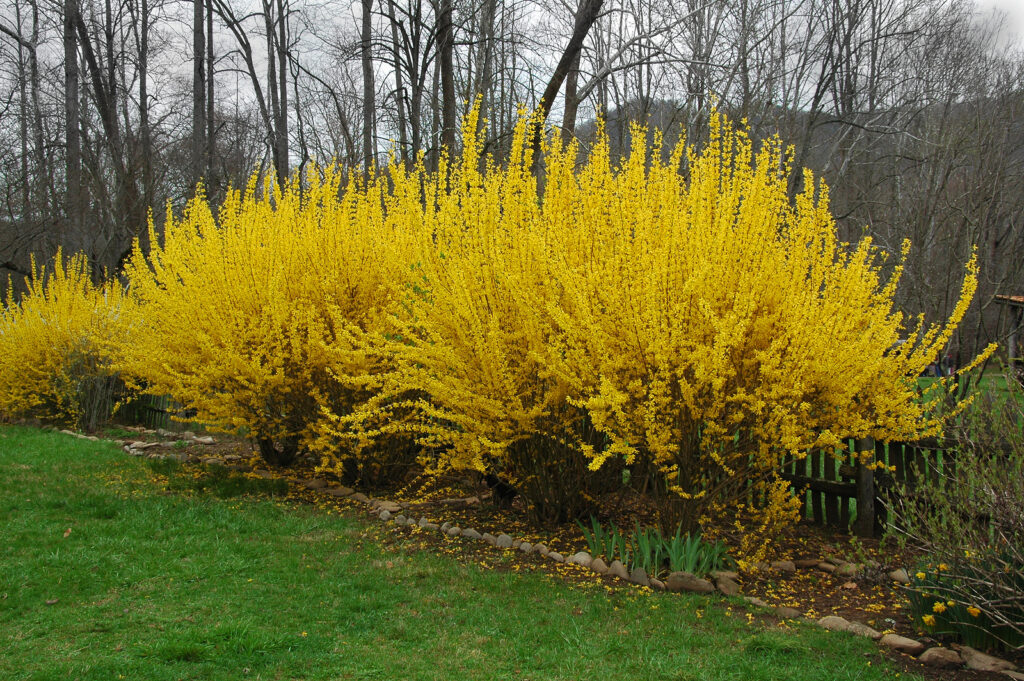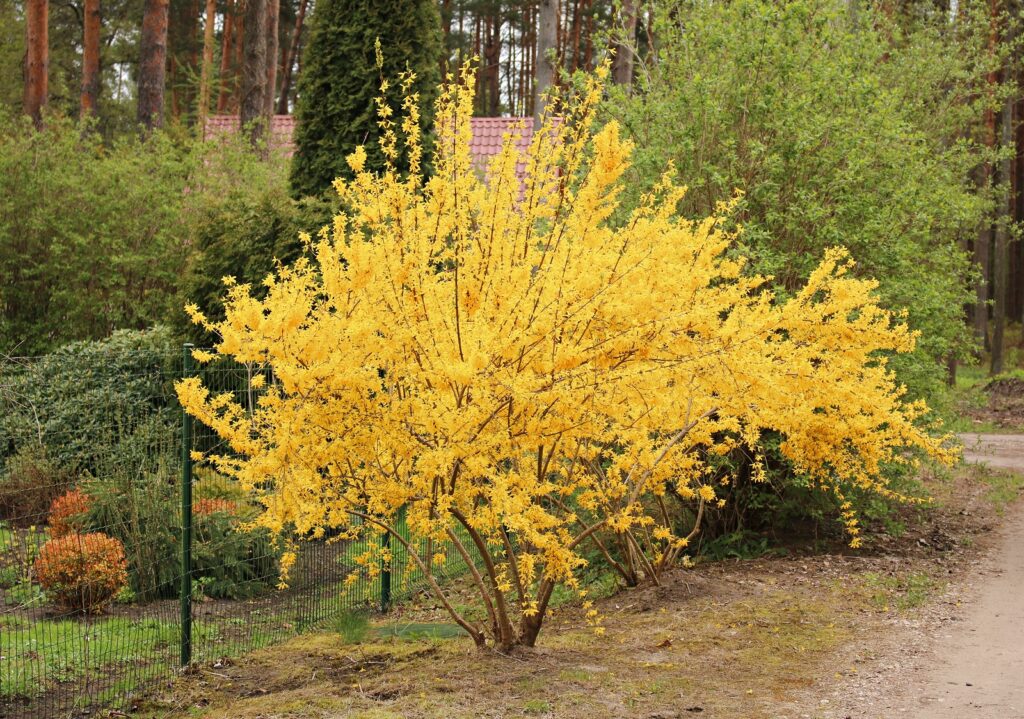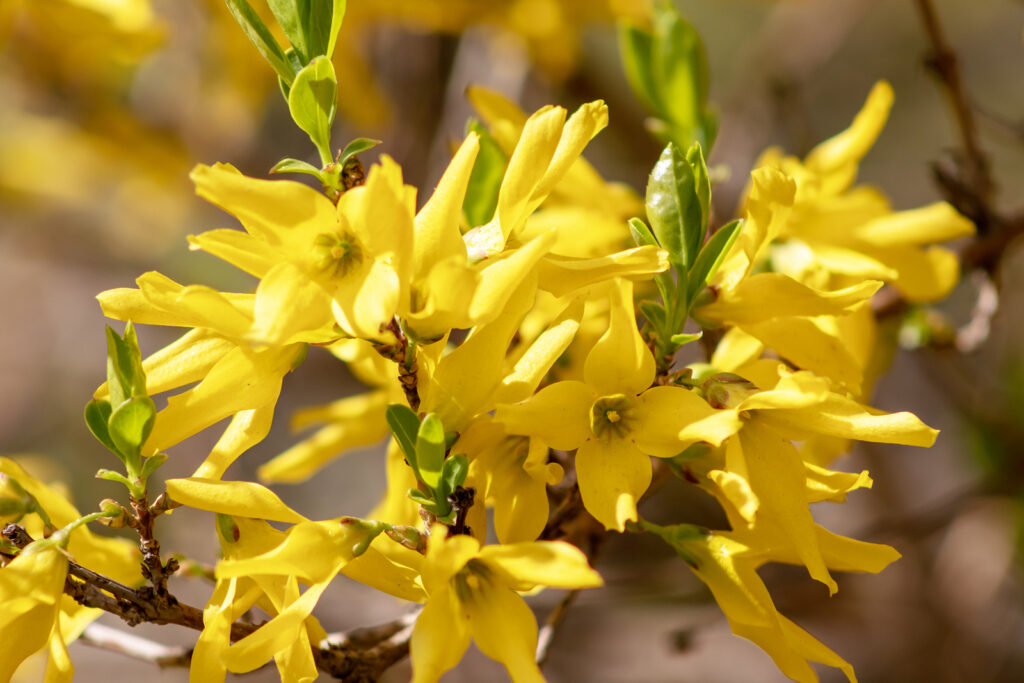Forsythia is a colorful harbinger of spring. Clusters of yellow flowers bloom before the leaves emerge. Yellow flowers range from pale primrose to deep brass. Forsythias vary in size from shrubs that grow 1 foot tall to others that reach 8 to 10 feet (2.6-3m) tall.
Forsythia has a fountain-like habit with arching branches. After the early spring show of yellow blossoms on bare wood forsythia’s medium green foliage appears and blends well with other shrubs in a background border planting, and screen. informal hedge, or as a hillside ground cover.
There are many forsythia cultivars; some have been developed for cold winter regions.

Get to know Forsythia
- Plant type: Deciduous early spring-blooming shrub
- Growing Zones and range: 4-8
- Hardiness: Hardy
- Height and width: 4 to 10 feet (1.2-3m) tall and 3 to 10 feet (.9-3m) wide depending on the cultivar.
- Foliage: Simple leaves are 2 to 3 inches (5-7.6cm) and are opposite; leaves appear as flowers finish.
- Flowers: 4-petaled yellow flowers are salverform–flared
- Bloom time: Early to mid-spring
- Uses: Shrub border, against a wall, as a specimen, hedging, groundcover
- Common name: Forsythia
- Botanical name: Forsythia intermedia
- Family: Oleaceae
Where to plant Forsythia
- Plant forsythia in full sun for best flowering; will tolerate light shade.
- Grow forsythia in average to humus-rich, well-drained soil.
- Forsythia prefers a soil pH of 5 to 8.

When to plant Forsythia
- Set container-grown forsythia in the garden in spring or fall.
Planting and spacing Forsythia
- Space forsythia 8 to 10 feet (2.4-3m) apart depending on the cultivar.

How to water and feed Forsythia
- Forsythia needs ample to moderate moisture; keep the soil evenly moist.
- There is no need to fertilize forsythia.
Forsythia care
- Mulch around forsythia to conserve soil moisture.
- Forsythia blooms on old wood grown the previous year. Little pruning is needed; do any necessary pruning immediately after flowering.
- Remove older weak-growing or dead wood after flowering; the bushes will then have the whole summer to produce fresh growth for next year’s blooms
- Do not shear forsythia; that would spoil its natural shape.
- To prune, cut out the oldest and weakest stems to just above the ground.
- Every few years cut forsythia back to about one foot above the ground to renew the plant and control size.
- Forsythia is prone to few serious pests or diseases.
Forsythia propagation
- Take softwood cuttings in summer or hardwood cuttings in late fall.
- Layer in fall.
- Remove suckers in the fall.

Forsythia varieties to grow
- Forsythia ‘Arnold Dwarf’: Grows to 3 feet tall and 7 feet wide; light flowering; good ground covers for banks and bare spots.
- Hardy hybrids: Cultivars for cold-winter regions includes ‘Meadowlark’ to 9 feet tall, ‘New Hampshire Gold’ to 5 feet tall, and ‘Northern Sun’ to 10 feet tall.
- F. intermedia: Most widely grown; grow 3 to 10 feet tall depending on cultivar; arching branks; all with deep yellow flowers. Cultivars include ‘Beatrix Farrand’, ‘Fiesta’, ‘Goldtide’, ‘Karl Sax’, ‘Lynwood’, ‘Spectabilis’, ‘Spring Gold’, and ‘Tetragold’.
- F. ovata, Korean forsythia: Shrub to 6 feet tall and wider; early bloomer; a profusion of yellow blooms.
- F.suspensa, weeping forsythia: Rambling shrub with yellow spring flowers, and arching branches; it grows 10 feet tall; pendulous branches.
- F. viridissima, green stem forsythia: Groundcover grows to 1 foot tall and 3 feet wide with pale yellow flowers.
Forsythia frequently asked questions
Q: There are many kinds of forsythia. Which do you consider the most beautiful?
A: Among the best forsythia are Forsythia intermedia spectablilis which has an unlike habit, and F. suspensa which has a fountainlike form.
Q: Which is the showiest forsythia?
A; Forsythia intermedia spectabilis is very showy.
Q: What is the hardiest forsythia?
A: Forsythia ovata is very hardy. It is the earliest blooming forsythia. If you have lost forsythias to cold winters, try Forsythia ovata.
Q: When is the best time to transplant forsythia?
A: You can safely transplant forsythia in spring or fall, whenever it is leafless.
Q: My forsythia bloomed in the fall. Will it bloom again next spring?
A: Forsythia forms its flower buds in the fall. If some buds open in the fall, they will be gone in spring and the plant’s blooms will be reduced.
Q: Why does my forsythia bloom only towards the bottom of the bush?
A: Forsythia forms flower buds in fall; they are present all winter long. Low temperatures can kill the buds. Buds toward the bottom of the shrub that was protected by snow will open and bloom in spring.
Q: How and when should forsythia be pruned?
A: Forsythia can be pruned in late winter or very early spring. Each year remove older branches cutting them near the base of the bush. The cut branches can be brought indoors and placed in water to force them into bloom. If you don’t prune before flowers open in very early spring, wait and prune immediately after the flowers have faded. If your forsythia has grown too tall, cut it back to the height you want immediately after flowering.
Q: Is there a way to keep forsythia from getting straggly and too tall?
A: You can keep forsythia more compact by pinching out the tips of strong-growing shoots during late spring and early summer. You can also plant comparatively compact varieties such as Forsythia ovata and F. viridissima.















